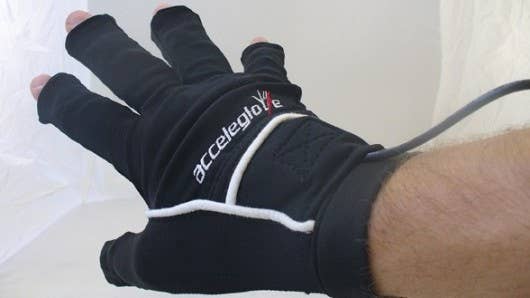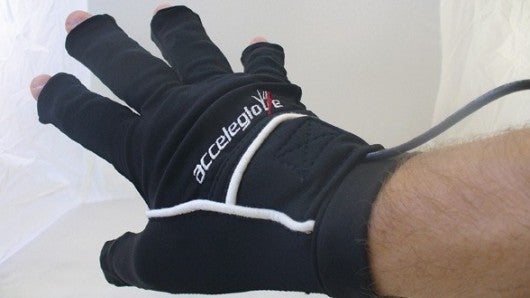AcceleGlove Remotely Controls Objects With Hand Gestures

Share
Anthrotronix is letting your hands do the talking. Their new acceleglove is an input device that reads the smallest movements of the fingers to control robots, communicate in American Sign Language, or let soldiers give commands in the field. The intuitive motion capture glove is set to provide a more instinctual and light-weight alternative to traditional robot control mechanisms. Check out the brief demo video with Jack Vice (Anthrotronix founder) after the break.

Did you just call me a Power Glove? Talk to the hand, fool.
For those of you who can't help but make comparisons to Nintendo's ill-fated Power Glove, you should know that the acceleglove is a much more sophisticated device....it's kind of like a Wiimote. Seriously, the glove uses many small accelerometers (hence the glove's name) to measure movements and orientations of the fingers. Those accelerometers are sensitive enough, and tiny enough, that a user feels like they are simply moving their hand in a traditional glove. That's great news for the intended users.
Who's wearing these things right now? Well Anthrotronix already has a software package setup on their site for American Sign Language users. The acceleglove is easily adapted to serve as an ASL recorder or translator. While the deaf community already communicates with the hearing well without this technology, I can imagine an ASL recorder/translator would work nicely for public speeches and community events. Though there are computers already learning sign language on their own which might work better than the glove.
On the other end of the spectrum, military uses for the acceleglove are promising. The vast array of human-robot interactions that will characterize the next generation of the US army need to be as simple and effective as possible. Already soldiers communicate with their hands to relay information and suggest broader tactical maneuvers. Using the acceleglove, robots could easily receive hand signals from commanders in the field for quick and adaptive responses as combat situations evolve. A support drone could be told to go high and scout for a sniper, or stay low to avoid fire, or bring in support; all using fast hand movements that soldiers already know.
Be Part of the Future
Sign up to receive top stories about groundbreaking technologies and visionary thinkers from SingularityHub.


When it comes to the next generation of robotic/computer interfaces, I'm not sure how the acceleglove will stack up. Jack Vice using finger motions to control a robot hand seemed a little contrived. Honestly, without some form of haptics I don't know how the glove can compete with fully immersive virtual reality controls. As we've discussed before, the computer-human interface may start focusing on moving the computer, or interacting with it tactically, in a way that cuts out the need for an input device of any kind.
Still, for what it does, the acceleglove seems to perform really well. Intuitive interfaces will always find a market even if it is a niche. Gamers, I'm sure, will put this thing to good use. Likewise, the ASL and military applications are pretty sound. It will be interesting to see if a third party developer or research scientists finds an interesting way to employ the acceleglove in a way that Anthrotronix hadn't considered. At $500, a single glove isn't cheap, but it's well within the budget of someone hoping to find a new use. If someone could include a way for users to receive sensations while wearing the acceleglove then I think it would be a truly revolutionary device.
Related Articles

This Light-Powered AI Chip Is 100x Faster Than a Top Nvidia GPU

Hugging Face Says AI Models With Reasoning Use 30x More Energy on Average

How Scientists Are Growing Computers From Human Brain Cells—and Why They Want to Keep Doing It
What we’re reading